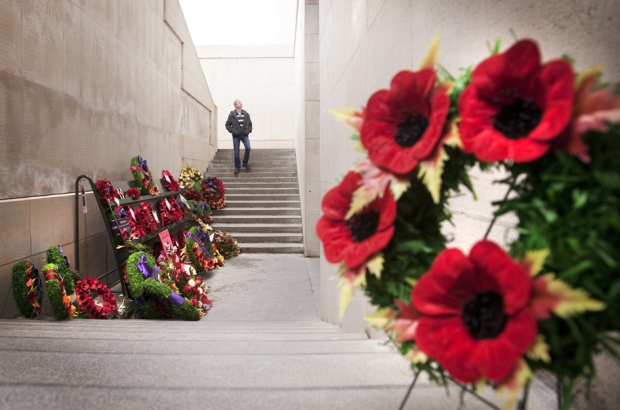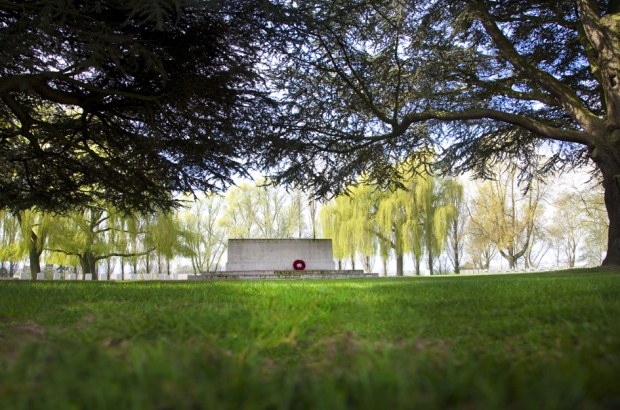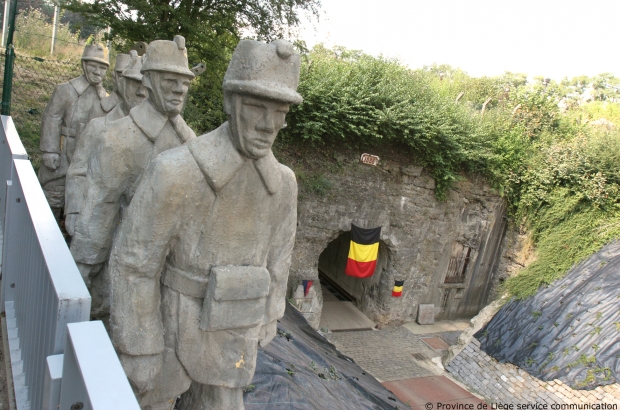- Daily & Weekly newsletters
- Buy & download The Bulletin
- Comment on our articles
Remembering World War One in Belgium
The horrors of World War One never fail to resonate. From the staggering statistics to the stories of conditions in the trenches of the Western front, the war continues to exert an irresistible fascination for all generations. And Belgium was at the centre of the action. It was witness to the start of the war in August 1914 and its end in November 1918, the first and last British soldiers were killed and are buried in Mons, and it was the backdrop for some of the war’s fiercest fighting.
At a national level, the Belgian government is focusing on three areas: collective remembrance; working together for future peace; and solidarity and partnership. Centenary events will be held on August 4 in Liège and October 28 in Nieuwpoort and Ypres. The first, at the Inter-Allied Memorial in Liège, will be attended by world leaders and members of the Belgian and British royal families, including the Duke and Duchess of Cambridge The second is an international remembrance of the First Battle of Ypres and the flooding of the Yser plain. The UK’s entry into the war is also marked on August 4, at the beautiful tree-flanked Saint-Symphorien Cemetery in Mons, the final resting place for British and German soldiers killed at the Battle of Mons.
Belgium’s experience of the war differed to that of other countries. The small and relatively new nation was drawn into the conflict by the violation of its neutrality. It experienced trench warfare, devastating battles and occupation, with civilians massacred, towns destroyed and communities pillaged. Misery and hunger led to the launch of the first international humanitarian aid in history.
Heroism was not restricted to the front line. A significant military and civilian resistance movement grew out of the population’s refusal to accept military invasion, despite the reprisals this incurred. Networks of informers – the most famous was La Dame Blanche, with 400 agents, half of them women, spread across the country – provided intelligence on rail transport, helped move wounded soldiers out of Belgium, assured a mail service and published forbidden patriotic newspapers such as La Libre Belgique.
One hundred years on, Belgium is honouring all the victims of the war and joining in an international reflection of the profound impact that the war had on its own history and that of the whole world.
How the war started in Belgium
With its neutrality guaranteed by an 1839 treaty signed by the chief actors of WWI, Belgium nevertheless feared attack by any one of its neighbouring countries and had strengthened its military defences at the end of the 19th century. Rings of fortresses had been built around Antwerp, Liège and Namur. In 1914, though, the Belgian army was still small and the majority of its soldiers reservists. For the Germans, it was a tempting alternative to the strong fortifications on the Franco-German border. The day before Germany declared war on France, it wrote to the Belgian government demanding free passage for its troops. Albert I, the ‘soldier king’, famously retorted: “Belgium is a nation, not a road.” But just after dawn on August 4, 1914, the German army crossed the border at Membach, in the strategic province of Liège, and two hours later, lancer Antoine Fonck became the first Belgian soldier to be killed.
For centuries, Belgium’s geographical position had earned it the dubious title Battlefield of Europe. Expecting little resistance, the German army was nevertheless stalled in Liège until it sent for its secret weapon, the long-range howitzer called Big Bertha. When its shell hit the powder reserve of Fort Loncin on August 15, killing the majority of the garrison, it effectively destroyed Belgium’s military resistance. Besieged Namur held off the Germans for a few more days, but the German Army then advanced across Wallonia, destroying villages and towns and massacring civilians. Brussels was occupied within two weeks of the declaration of war.
The Belgian army retreated to Antwerp on August 17 while the Germans’ unexpected delay in Liège and Namur gave both British and French armies time to amass their forces. It resulted in the Battle of the Frontiers, a series of battles in the south of Belgium and along the eastern frontier of France, that resulted in terrible losses for the French Army and reprisal killing of thousands of Belgians. The small British Expeditionary Force (BEF) moved into position south of the Mons-Condé canal on August 23.
As the French needed to fall back, the British were requested to hold the canal. Though outnumbered, the BEF was a veteran force with outstanding rifle and machine-gun skills. Its first skirmish with Germany began that day, with Drummer Edward Thomas firing the first British shots. Early the following morning the Germans launched an attack on British lines at two bridges over the canal at Nimy. Already prepared, the BEF succeeded in decimating German ranks until the arrival of further troops forced the British to prepare their own retreat. In the early afternoon Mons was abandoned and the British fell back into northern France. The first two Victoria Crosses of the war were awarded at the Battle of Mons, to machine-gunner Private Sidney Godley, buried at Saint-Symphorien, and Lieutenant Maurice Dease. There are plaques in memory of both soldiers on the bank of the canal beneath Nimy Bridge.
By September, German armies were advancing towards Paris, until the French launched a surprise attack in the Marne and the BEF exploited a breach in German lines. The German advance had been halted but there was now a race to the sea as both sides moved towards the North Sea. Each built a series of trenches which would characterise the next four years of combat. As the Allies reached Nieuwpoort, German forces descended from Antwerp and thus began the First Battle of Ypres on October 14. In the following weeks, casualties mounted on both sides as German assaults almost succeeded in taking the medieval town. Fighting around Ypres continued until the onset of winter weather forced a break in hostilities. The ‘First Ypres’ became a synonym among soldiers for gaining fighting experience. The British held the town and did so until the end of the war, with the Allies also controlling a small area extending into German lines, known as a salient. This was the start of a lengthy stalemate in which the line of the Western front was barely to change. Belgium was almost entirely occupied except for a sliver of land in northwest Flanders, which would become one of the most strategic areas of Belgium and the scene of two further major battles, in 1915 and 1917.
The international community remembers
For Britain’s ambassador to Belgium, Jonathan Brenton, the centenary reinforces historical links between the two countries. “When King Albert of Belgium died in 1934, King George was sufficiently moved to give Belgian soldiers the right to march at the Cenotaph on November 11; and the tomb of the unknown soldier at Westminster Abbey is covered by black marble from Namur.”
These links include longstanding political and trade links and the embassy recognises that this year is important for bilateral relations. The UK is organising the commemoration service at Mons on August 4, in the presence of foreign dignitaries and members of the Belgian and British monarchy. For the ambassador, “these events celebrate the fact that Europe is now so different. While it is hard to draw a direct link between the First World War, because it led to the Second World War, and the peaceful democratic Europe that we have today, it is one reason why we now have a very different Europe,” he says.
“2014 is a big landmark and a moment when we are obliged to think about history and the sacrifice of previous generations. This year is a chance for us all to reflect. The historical debate is also very valuable and it is an opportunity to challenge some of the stereotypes.”
The Australian Embassy in Belgium has organised a 200km remembrance trail along the Western front to explain the nation’s experience in France and Belgium. Three sites in Flanders have been targeted: Ypres, Tyne Cot cemetery and Toronto Avenue cemetery in Ploegsteert Wood. Every year Australia and New Zealand commemorate Anzac Day on April 25, originally to honour the landing by their soldiers at Gallipoli in Turkey in 1915; each embassy takes it in turn to organise the event. New Zealand suffered heavy losses in WWI, and official visits by the country to Belgium frequently involve visiting battlefields and laying wreaths. Large numbers of New Zealanders travel to Belgium to explore their family’s links with the war.
Canadian soldiers lost in both world wars are honoured in commemoration ceremonies every year throughout Belgium. The Irish Embassy, meanwhile, has launched the country’s WWI memorial records in partnership with In Flanders Field Museum, Google and private heritage specialists Eneclann.
There may no longer be any survivors of the Great War, but its memory is being perpetuated, as new technology means records, photographs and archives are now being digitalised. The many services, events and exhibitions being staged over the next four years are a unique moment to learn about this period in history. It was an extraordinary era that radically changed society, from technological and medical advances to the politics and economy of the 20th century. One hundred years on, with conflict still raging in the world, remembrance of earlier wartime human sacrifice continues to resonate.
http://www.belgium-tourism.be/contenus/wallonia-land-of-remembrance/en/7277.html
http://www.be14-18.be/en
Sites to visit
In Flanders Field Museum, Ypres, inflandersfields.be
Tyne Cot Cemetery, Zonnebeke, & Saint-Symphorien Cemetery, Mons, http://www.cwgc.org/
Plugstreet 14-18 Experience, plugstreet1418.com
Talbot House, Poperinge, talbothouse.be
American Battle Monuments Commission, http://www.abmc.gov/
Langemark German Military Cemetery, vredeswakeslangemark.be
Fort Loncin, Liège, fortdeloncin.be
Battlefield tours
Flanders Battlefield Tours If you’re short of time, Flanders Battlefield Tours offers a range of minibus tours covering different areas. The standard tour includes Hill 60, Polygon Wood and the Memorial Museum Passchendaele 1917. For the North Salient, take the grand tour and see Essex Farm – the location of the bunker where John McCrae wrote In Flanders Fields – the sombre oak tree-filled German cemetery at Langemark, Tyne Cot cemetery in Passchendaele and Hill 62, among other sites. The extended tour visits the South Salient and the site of the Battle of Messines: Bayernwald German trenches, Plugstreet, the field where the Christmas Truce took place in 1914, Irish Peace Park, New Zealand memorial and Messines Ridge. Booking is recommended, www.ypres-fbt.com
Cycling the Western Front Combine a battlefield tour with a spot of exercise by pedalling around the area. Most of the action during the Great War took place within a fairly small – and generally flat – area. The sites are only about 4 to 8km apart and can easily be visited by bicycle. Tours are personally guided and cover all ages and abilities. One-day tours are the standard, but multiple-day tours can be arranged and include accommodation and transportation of your overnight luggage. The Ypres tour visits Menin Gate, Essex Farm, Artillery Wood, Langemark cemetery, Polygon Wood, Hill 62, Hill 60 and Messines Ridge, among others, www.cyclingthewesternfront.co.uk
Salient Tours The Ypres Salient standard tour is a four-hour minibus trip to the major sites. Alternatively, if you’re short of time, there is a 2.5-hour afternoon tour which takes in additional places such as Hill 60, Caterpillar Crater, German trenches and Bedford House Commonwealth cemetery (some visitors combine the two). Both cover Anzac and Canadian sites.
www.salienttours.be
Willie Mohan Tours Brussels-based Irishman Willie Mohan has been giving personalised battlefield tours for more than 30 years. In addition to an encyclopaedic knowledge of the war, Mohan has a knack for bringing it to life. The former soldier and retired London policeman tells stories of how the men lived, fought and died on the battlefield, as well as providing vital historical context. He describes his tours as ideal for those who want something less sedentary, with lots of walking and pit stops. As he explains, “The battles of Ypres and Waterloo mean that the battlefields of Belgium have a special resonance for many people.” www.wm-tours.com
2Xplore Tours Offering customised battlefield tours in English, Patrick Jonckheere, an ex-Belgian para commando has a real passion for the history of the Great War. As a local he can take you to private sites off the beaten path. The Ypres Salient tour, which includes the Tyne Cot cemetery, the Passchendaele Memorial and the preserved battlefield at Hill 60, is an all-inclusive one-day tour, while a separate evening tour takes in the Last Post ceremony at Menin Gate in Ypres. Jonckheere also designs customised tours. All tours include entrance fees and an information pack, www.2xplore.be
This article first appeared in The Bulletin's Newcomer spring 2014 issue






















